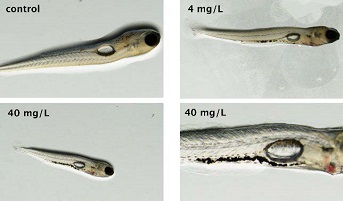Consensus reached on how to set thresholds for aquatic life exposed to microplastics

A group of international experts on aquatic microplastics pollution has reached consensus on a recommended framework that California could use to implement health-based thresholds that explain when microplastics contamination at different levels can be expected to trigger adverse biological effects in aquatic life.
The proposed management framework, which will be formally unveiled during a public webinar meeting on September 8, 2021, features four numeric thresholds for microplastics that, when exceeded, would trigger specific follow-up management actions, such as targeted microplastics monitoring, initiation of mitigation strategies, or posting of fish consumption advisories.
The framework, along with the initial proposed thresholds that are aligned to it, could help inform the ongoing development of a comprehensive California management strategy for mitigating the ecological risks of microplastics pollution in coastal marine ecosystems. The California Ocean Protection Council is required under Senate Bill 1263 to develop this microplastics ocean management strategy by the end of 2021.
The framework and thresholds are the product of nine months of deliberations by microplastics researchers from around the world; the participants convened virtually through the Microplastics Health Effects Workshop, a multi-component event co-hosted and facilitated by SCCWRP that began last fall.
While the microplastics experts who participated in the workshop were able to reach consensus on recommendations for how to set health-based thresholds for aquatic life, they were not able to develop similar recommendations for setting thresholds for humans who consume drinking water.
The experts concluded that existing human health data are still too limited to be able to propose numeric microplastics thresholds for drinking water. Instead, the experts developed a conceptual framework into which human health-related microplastics thresholds could be subsequently developed, and provided recommendations on how to design studies capable of generating the data necessary to develop these thresholds in the future.
The health effects of microplastics exposure is not the only area that researchers have been studying. In parallel with the Microplastics Health Effects Workshop, an international group of microplastics experts also has been working to ensure researchers and managers worldwide are using robust, standardized methods to measure microplastics.
In June, a group of 40 laboratories in six countries completed a SCCWRP-facilitated intercalibration study that compared five different measurement methods. The findings of the intercalibration study are expected to inform the development of a draft policy that will require microplastics to be monitored in drinking water; the draft policy is expected to be released by the end of 2021.
In developing proposed microplastics health-based thresholds for aquatic life, the scientific experts decided to focus on two relevant pathways by which aquatic organisms can be adversely impacted due to microplastics exposure:
» Food dilution: When fish and other aquatic organisms ingest microplastics, the particles can cause false satiation and reduced nutrient absorption.
» Tissue translocation: When tiny microplastics particles less than 100 micrometers migrate from the gut into other issues, the particles can trigger oxidative stress and tissue damage.
For both of these pathways, researchers derived health-based thresholds using a method known as Species Sensitivity Distribution, which is commonly used in risk assessment to determine pollutant levels that will protect 90-95% of exposed species from adverse biological effects.
The microplastics experts also estimated the levels of uncertainty associated with the microplastics thresholds they proposed, concluding that uncertainty levels were moderate and that more data are needed to improve confidence.
The threshold-setting approach and initial set of numeric thresholds will be described in a forthcoming journal publication, as well as during a public webinar meeting scheduled for September 8, 2021. To register for the webinar, go to the Microplastics Health Effects Workshop page.
For more information, contact Dr. Alvina Mehinto or Dr. Leah Thornton Hampton.
More news related to: Emerging Contaminants, Top News, Trash Pollution